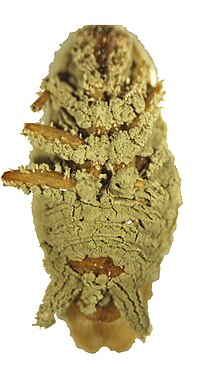
Photo from wikipedia
Beauveria bassiana is an entomopathogenic fungus that causes the white muscadine disease in insects. The majority of entomopathogenic fungi are soil and insect borne, 15 soil samples were collected from… Click to show full abstract
Beauveria bassiana is an entomopathogenic fungus that causes the white muscadine disease in insects. The majority of entomopathogenic fungi are soil and insect borne, 15 soil samples were collected from seven different locations during 2021, from January to December. Similarly, during 2022, March to December, 15 fungus-infected insect specimens were collected from five different locations hence soil and insect samples from various ecosystems were collected. As a result, 30 B. bassiana isolates from 11 different geographical areas were identified using morphological characteristics and multilocus sequence data in this investigation. The taxonomical positions of the isolates were determined using morphological characteristics and phylogenetic inferences based on three loci (Internal Transcribed Sequence, Elongation Factor-1α, and B. bassiana chitinase 1). In phylogenetic analysis of B. bassiana, the Maximum Likelihood analytical method produced distinct tree topology when compared to Neighbor-joining and minimum evolution. Three isolates viz., Bb3, Bb7 and Bb20 were found closely linked with reference isolate (KTU-24) and other showed the higher population diversity among them. The genetic distances of 30 B. bassiana isolates revealed that 15 were not closely related (D varied from 0.003 to 0.036). The pathogenicity of B. bassiana isolates from various hosts along with one commercial formulation (Beveroz) was assessed against Tetranychus truncatus under in vitro conditions by a completely randomized design (CRD) experiment. The same experiment was repeated thrice to confirm the pathogenicity of B. bassiana against T. truncatus. Later, the collected T. truncatus mortality data was converted into corrected mortality by using the Abbott formula and the values were examined using analysis of variance (ANOVA) in SPSS 23.0 software. Duncan’s Multiple Comparison Test was also done to compare the percentage mortality rates among the 30 B. bassiana isolates. The recorded results showed that the Bb6, Bb15 and Bb12 isolates caused significantly higher mortality of T. truncatus, i.e., 97.73, 96.73 and 94.50% respectively, than the other isolates. This study showed the relativeness among the B. bassiana isolates and establishes their bio-efficacy against T. truncatus, which further can be used for commercialization as bio-pesticide.
Journal Title: Frontiers in Microbiology
Year Published: 2022
Link to full text (if available)
Share on Social Media: Sign Up to like & get
recommendations!